Building a dazzling jewelry photography portfolio requires mastering technical precision and artistic vision to showcase your unique style. You’ll need high-resolution equipment, macro lenses, and expert lighting techniques to capture gemstone brilliance while eliminating harsh reflections. Curate 10-15 impactful images that demonstrate versatility across different jewelry types, maintain consistent editing for brand identity, and choose platforms that support high-resolution displays. Focus on quality over quantity to create emotional resonance with potential clients. The secrets to transforming amateur shots into professional masterpieces await your discovery.
Understanding the Purpose of Your Jewelry Photography Portfolio
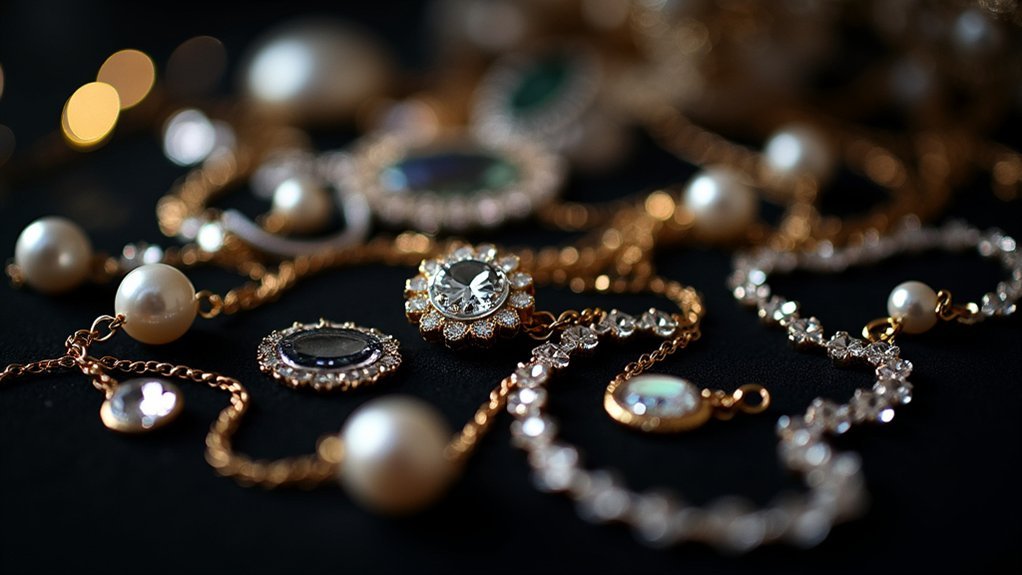
When you’re building a jewelry photography portfolio, you’re fundamentally creating your visual business card that speaks before you even enter the room. Your portfolio showcases your unique style and technical skills while demonstrating your ability to capture intricate details that drive purchasing decisions.
It’s your chance to establish brand identity and differentiate yourself in a saturated market through curated visual appeal. Your jewelry photography portfolio serves multiple purposes: attracting potential clients, reinforcing recognition, and reflecting your artistic vision.
Each image should highlight craftsmanship while showcasing your evolving skills. Focus on quality over quantity by selecting 10-15 impactful images that represent your niche expertise.
Defining Your Unique Style and Artistic Vision
While developing your unique style begins with examining your natural tendencies behind the camera, you’ll discover that your artistic vision emerges through deliberate choices about how you interpret jewelry’s inherent beauty.
Start by analyzing your strongest photographs—identify recurring color palettes, composition patterns, and emotional qualities that define your work naturally.
Focus on a specific niche, whether it’s vintage estate pieces or contemporary minimalist designs, to establish expertise and attract targeted clients.
Experiment systematically with lighting setups, backgrounds, and props to understand how each element influences your images’ mood and character.
Most importantly, maintain consistent editing techniques across all portfolio pieces. This cohesive visual identity strengthens brand recognition and guarantees your artistic vision remains clear and memorable to potential clients browsing your work.
Selecting Equipment for Professional Jewelry Photography
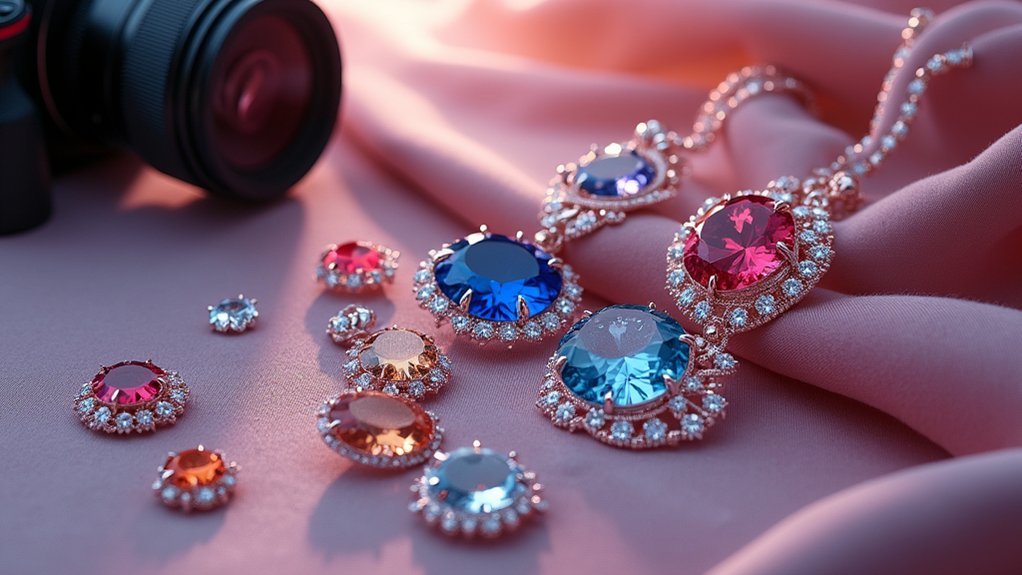
You’ll need the right equipment to transform your artistic vision into stunning jewelry photographs that captivate potential clients.
Your camera and lens choices form the foundation of your setup, while proper lighting equipment guarantees you can showcase each piece’s brilliance and detail.
These technical decisions directly impact whether your portfolio demonstrates the professional quality that sets you apart in the competitive jewelry photography market.
Camera and Lens Selection
Professional jewelry photography demands precision equipment that can capture every facet, texture, and sparkle with stunning clarity. Your camera and lens selection forms the foundation of exceptional results. You’ll need a DSLR or mirrorless camera with at least 20 megapixels to capture intricate details effectively.
Essential equipment for professional jewelry photography includes:
- High-resolution camera (minimum 20 megapixels) for detailed shots
- Macro lens for sharp close-up photography of small jewelry pieces
- Sturdy tripod to prevent camera shake and maintain image clarity
- Tilt-shift lenses for creative depth of field control
- Excellent autofocus capabilities to guarantee precise focus on gemstones
A quality macro lens is vital for capturing tiny details and textures. Your tripod provides stability during low-light shooting, while superior autofocus capabilities prevent blurred images and enhance overall quality.
Lighting Equipment Essentials
Mastering jewelry photography requires exceptional lighting equipment that illuminates every sparkle and detail with precision.
Your lighting equipment essentials should include softbox lights or studio lamps with diffusers that create diffused lighting, reducing harsh shadows and unwanted reflections on metallic surfaces.
LED ring lights are invaluable for their consistent color temperature and even illumination, perfectly capturing intricate jewelry details.
You’ll want to incorporate reflectors to bounce light and fill shadows, enhancing brightness without creating glare.
Consider investing in a light tent or light box for controlled lighting environments that eliminate external interference while providing clean backgrounds.
Don’t overlook natural light opportunities—shooting near windows during golden hour offers soft, warm illumination that beautifully highlights jewelry’s brilliance and fine details.
Mastering Lighting Techniques for Different Jewelry Types
Three fundamental lighting principles separate amateur jewelry photography from professional-quality images that showcase every facet and detail.
Mastering proper lighting techniques transforms ordinary jewelry shots into stunning professional images that capture every brilliant detail and sparkling facet.
You’ll need to master soft diffuse lighting using studio lamps with diffusers to eliminate harsh shadows while revealing intricate jewelry details. Natural light enhances gemstone sparkle, but you must diffuse it through sheer curtains or reflectors.
For reflective surfaces like gold and silver, polarizing filters minimize unwanted reflections while enhancing clarity. Adjust your color temperature based on jewelry type—warmer tones complement gold while cooler tones enhance silver’s appeal.
- Use studio lamps with diffusers for controlled, shadow-free illumination
- Diffuse natural light with sheer curtains or reflectors for gemstone photography
- Apply polarizing filters to reduce reflections on metallic surfaces
- Match color temperature to jewelry type for ideal visual appeal
- Experiment with angles and distances for dramatic highlights
Curating Your Best Images for Maximum Impact

You’ll face the temptation to include every decent shot you’ve captured, but your portfolio’s power lies in ruthless selection of only your most exceptional work.
Each image must earn its place by showcasing technical mastery and artistic vision that sets you apart from competitors.
The sequence of your chosen images creates a visual journey that should build momentum and leave viewers remembering your strongest pieces.
Quality Over Quantity
The temptation to showcase every decent shot you’ve captured can sabotage your jewelry photography portfolio’s effectiveness. Quality over quantity should guide your selection process when curating jewelry photos. Each image must demonstrate technical excellence and emotional resonance. Your essential equipment investments mean nothing if you’re diluting strong work with mediocre shots.
You’ll create a more powerful impression by being ruthlessly selective. Evaluate each photograph for sharpness, composition, and storytelling ability. Remove images that don’t meet your highest standards, even if they’re technically acceptable.
Consider these quality assessment criteria:
- Technical precision – Perfect focus, exposure, and color accuracy
- Emotional impact – Images that evoke desire or admiration
- Compositional strength – Well-balanced, visually compelling arrangements
- Clarity of purpose – Each shot serves a specific portfolio objective
- Professional polish – Consistent editing and presentation standards
Strategic Image Sequencing
Once you’ve identified your strongest jewelry photographs, arrange them strategically to create maximum visual impact.
Strategic image sequencing transforms your portfolio from a random collection into a cohesive story that guides viewers through your artistic vision. Begin with your most attention-grabbing shot to hook viewers immediately, then group related jewelry pieces from the same series together to establish your style and approach.
Maintain momentum by thoughtfully sequencing your high-quality images to create excitement and engagement. Each photograph should contribute meaningfully to your overall narrative while showcasing the unique qualities of different jewelry pieces.
Limit your selection to 10-15 images per niche to avoid overwhelming viewers. End with a memorable piece that reinforces your identity as a jewelry photographer, leaving a lasting impression.
Creating Consistent Brand Identity Across Your Portfolio
When potential clients browse through countless jewelry photographers’ portfolios, yours needs to stand out with a distinctive visual identity that’s instantly recognizable.
Consistent branding transforms scattered images into a cohesive professional presentation that reflects your unique artistic vision. Your cohesive color palette should flow seamlessly throughout every photograph, creating a unified visual language that clients can immediately associate with your work.
Building strong brand identity requires deliberate choices in every element of your portfolio presentation:
- Maintain identical lighting setups and background treatments across all jewelry shots
- Use your logo and consistent typography on website headers, watermarks, and printed materials
- Apply the same compositional approaches and styling elements throughout your work
- Keep color grading and post-processing techniques uniform across all images
- Review your portfolio quarterly to guarantee continued alignment with your evolving brand aesthetic
Organizing and Sequencing Images for Visual Storytelling

Every image you select tells part of a larger story, and strategic sequencing transforms individual photographs into a compelling visual narrative that captivates potential clients from first glance to final impression.
When organizing images, structure your portfolio with a clear beginning, middle, and end to enhance viewer engagement. Group related series together to maintain a coherent theme throughout your visual journey.
Balance close-up detail shots with lifestyle images, guiding viewers seamlessly from intricate craftsmanship to real-world appeal. Thoughtful sequencing creates excitement and anticipation as clients navigate through your work. Each photograph should contribute meaningfully to your overall narrative.
Conclude with a powerful image that encapsulates your unique style and photographic identity, ensuring you leave a lasting impression that resonates long after viewing ends.
Showcasing Versatility Through Different Jewelry Categories
While a stunning engagement ring photograph might initially draw viewers into your portfolio, demonstrating your expertise across diverse jewelry categories transforms casual browsers into committed clients who trust your versatility.
Showcasing versatility requires mastering unique challenges each jewelry type presents. Rings demand different angles to highlight gemstone brilliance and band details. Necklaces need strategic draping and length considerations. Bracelets require careful positioning to show clasp mechanisms and charm arrangements. Earrings benefit from paired presentations that capture intricate details.
- Feature rings, necklaces, bracelets, and earrings equally throughout your portfolio
- Include both luxury pieces and affordable styles for broader market appeal
- Combine lifestyle shots with traditional product photography for context
- Experiment with styling techniques specific to each jewelry category
- Update regularly with trending styles to maintain portfolio relevance
Post-Processing Techniques for Stunning Jewelry Images
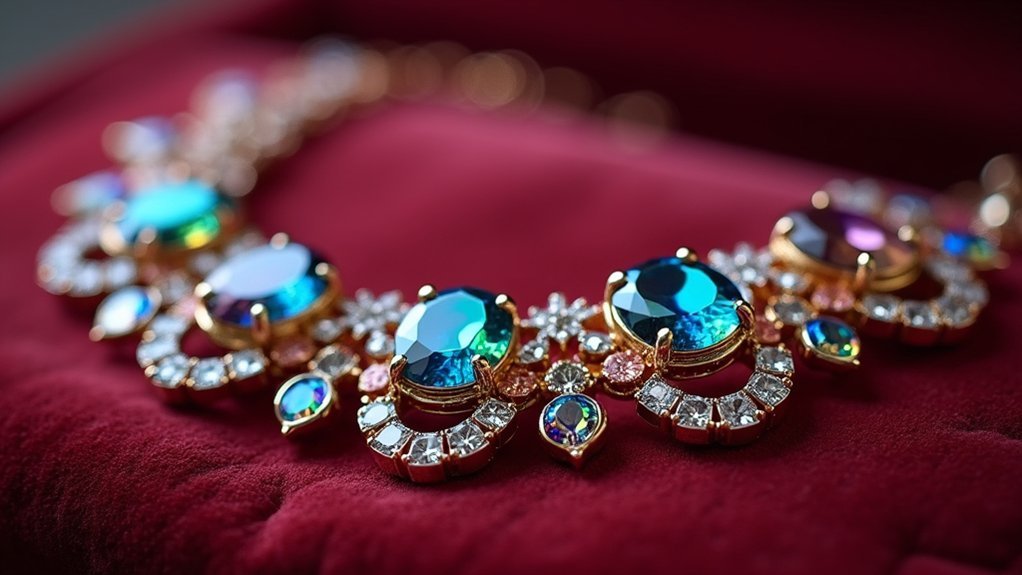
Capturing diverse jewelry categories in your camera represents only half the creative process—transforming those raw images into portfolio-worthy masterpieces happens during post-processing.
Shooting in RAW format preserves all sensor information, giving you maximum flexibility for extensive retouching without quality loss. Utilize non-destructive editing in Photoshop or Lightroom to maintain your original files while adjusting exposure, contrast, and sharpness.
Leverage RAW’s exceptional Dynamic Range to fine-tune highlights and shadows, creating perfectly balanced exposures that enhance jewelry’s vibrancy and detail.
You’ll want to remove distractions like dust or scratches, but exercise restraint to preserve each piece’s natural texture.
Finally, optimize your images for their intended use—resize for quick web loading while maintaining visual quality, choosing JPEG for e-commerce and TIFF for print applications.
Choosing the Right Platform for Your Digital Portfolio
Where should you showcase your meticulously crafted jewelry images to maximize their impact? Selecting the right platform is vital for presenting your work professionally and attracting potential clients.
Consider these essential features when choosing your portfolio platform:
- High-resolution image support – Guarantees intricate jewelry details remain crisp and visible
- Customizable templates – Allows your unique style to shine through personalized layouts
- Easy navigation and organization – Helps clients find specific jewelry styles effortlessly
- Regular update capabilities – Enables quarterly refreshes with your latest masterpieces
- Social sharing features – Promotes your work across multiple social media channels
Adobe Portfolio, Squarespace, and Behance offer responsive designs with these capabilities.
Your chosen platform should facilitate seamless user experience while highlighting your jewelry photography’s exceptional quality and craftsmanship.
Building an Online Presence and Marketing Strategy
Once you’ve established your digital portfolio platform, developing an extensive marketing strategy becomes your next essential step toward attracting clients and growing your jewelry photography business.
Start by leveraging social media platforms like Instagram and Pinterest to showcase your work, as these visually-driven networks naturally attract clients seeking to enhance jewelry through professional photography.
Create a mailing list to update subscribers about new portfolio additions and special promotions, keeping your services top-of-mind for online shopping decisions.
Optimize your website using SEO best practices with relevant keywords to improve search visibility.
Additionally, participate in photography competitions and exhibitions to gain industry recognition while building valuable networking connections that can generate referrals and expand your client base.
Maintaining and Updating Your Portfolio for Continued Growth
Your marketing efforts will only remain effective if your portfolio continues to evolve and improve over time. Maintaining and updating your jewelry photography portfolio requires consistent dedication to showcasing your growth and adapting to market demands.
Review your work quarterly to verify it reflects current trends and your evolving style. Experiment with different lighting setups to make each jewelry look fresh and distinctive. Incorporate feedback from mentors and peers to refine your approach, then analyze your website analytics to identify which images resonate most with viewers.
- Schedule quarterly portfolio reviews to maintain current relevance
- Experiment with different lighting techniques for varied jewelry presentations
- Gather and implement feedback from industry professionals and peers
- Include 10-15 high-quality images per jewelry category or style
- Track analytics to understand audience preferences and optimize content selection
Frequently Asked Questions
What Camera Setting Is Best for Jewelry Photography?
You’ll want manual mode with f/8-f/16 for sharp focus, 1/125s+ shutter speed preventing blur, and ISO 100-200 minimizing noise. Adjust white balance for accurate colors when capturing jewelry’s intricate details.
How to Create a Good Photography Portfolio?
You’ll need 10-15 high-quality images showcasing your unique style. Organize them into a cohesive narrative, update quarterly, include client testimonials, and use a responsive platform for ideal viewing.
What Is the Best Background for Jewelry Photography?
You’ll achieve best results with neutral backgrounds like white, black, or gray that won’t distract from your jewelry. Consider textured surfaces like velvet for luxury appeal, or monochromatic backgrounds that complement your pieces’ colors.
How to Make Jewelry Sparkle in Photography?
You’ll make jewelry sparkle by using diffused lighting to eliminate harsh shadows, positioning pieces on reflective surfaces like glass, and adjusting angles to catch light. Post-process RAW images to enhance brilliance and contrast.
In Summary
You’ve now equipped yourself with the essential knowledge to create a stunning jewelry photography portfolio. Remember, consistency in your artistic vision and technical execution will set you apart from competitors. Don’t rush the process—carefully curate each image and continuously refine your skills. Your portfolio isn’t static; it’s a living showcase of your evolving talent. Keep experimenting, stay updated with industry trends, and let your unique perspective shine through every photograph you create.



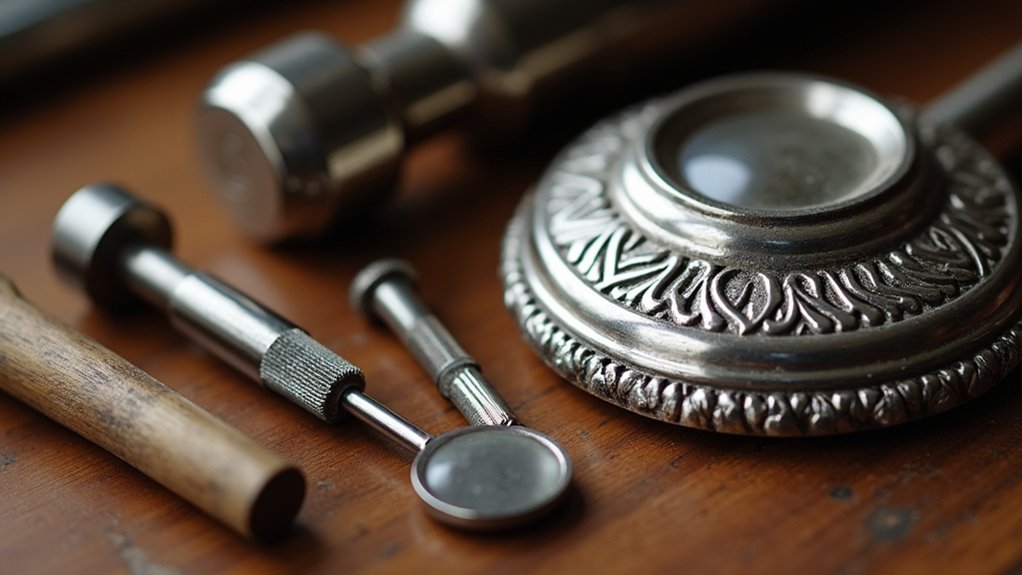
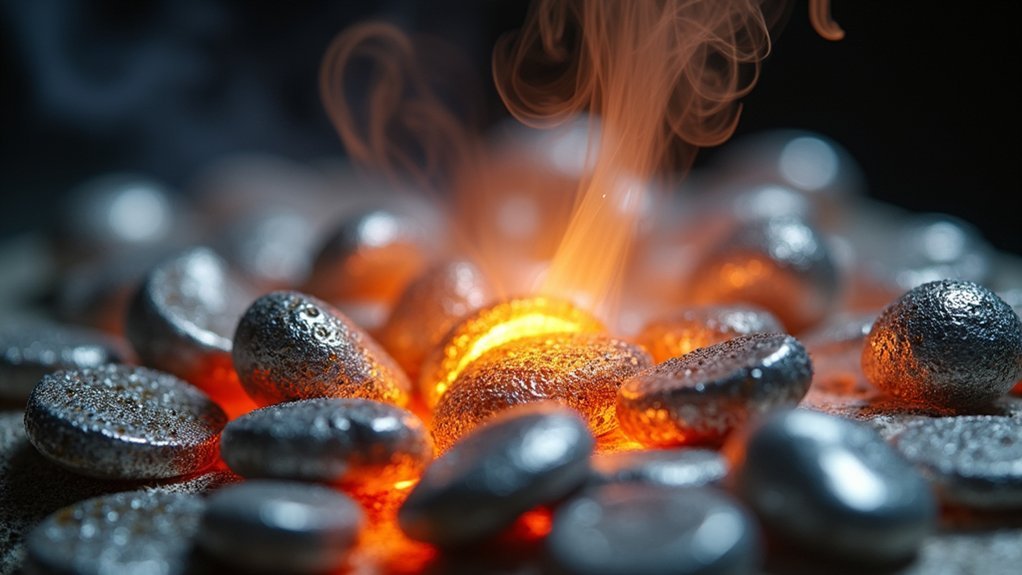
Leave a Reply